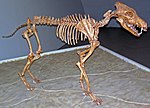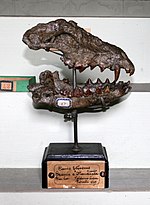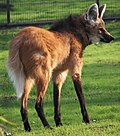body size in comparison to modern gray wolf populations. Genetic analysis of the remains of Late Pleistocene wolves suggest that across their range populations...
78 KB (8,346 words) - 11:57, 13 September 2024
simus), the modern cougar (Puma concolor), the Pleistocene coyote (Canis latrans), and the Pleistocene gray wolf that was more massive and robust than today...
108 KB (11,677 words) - 18:56, 11 July 2024
the grey wolf can be traced back 2 million years to the Early Pleistocene species Canis etruscus, and its successor the Middle Pleistocene Canis mosbachensis...
176 KB (18,959 words) - 18:58, 21 August 2024
wolf (Canis lupus spelaeus) is an extinct glacial mammoth steppe-adapted white wolf that lived during the Middle Pleistocene to the Late Pleistocene....
24 KB (2,904 words) - 22:42, 26 July 2024
Domestication of the dog (redirect from Domestication of the wolf)
substantial dog-into-wolf gene flow, with the modern grey wolf being the dog's nearest living relative. An extinct Late Pleistocene wolf may have been the...
172 KB (20,424 words) - 17:15, 17 September 2024
clear. The Beringian wolf was similar in size to the modern Alaskan Interior wolf (Canis lupus pambasileus) and other Late Pleistocene gray wolves but more...
75 KB (8,298 words) - 20:58, 9 July 2024
genetically distinct Italian wolf to be considered as a subspecies. In 2019, an mDNA study of 19 Late Pleistocene-Holocene wolf samples from northern Italy...
49 KB (5,499 words) - 00:43, 9 September 2024
Subspecies of Canis lupus (redirect from Subspecies of the Grey Wolf)
lineage as modern wolves, and proposed that dogs may be descended from a Pleistocene wolf closer in size to a village dog. In 2021, the American Society of Mammalogists...
93 KB (7,156 words) - 20:18, 17 September 2024
The Indian wolf (Canis lupus pallipes) is a subspecies of gray wolf that ranges from Southwest Asia to the Indian subcontinent. It is intermediate in size...
39 KB (4,298 words) - 01:14, 18 September 2024
morphological diversity existed among wolves by the Late Pleistocene. Many Late Pleistocene wolf populations had more robust skulls and teeth than modern...
123 KB (13,613 words) - 23:25, 19 September 2024
The Late Pleistocene to the beginning of the Holocene saw the extinction of the majority of the world's megafauna (typically defined as animal species...
202 KB (19,725 words) - 09:51, 13 September 2024
studies suggest that the Pleistocene "coyote" was not in fact a coyote, but rather an extinct western population of the red wolf (C. rufus). Compared to...
11 KB (1,355 words) - 19:05, 18 March 2024
the wolf lineage dates back to 2 million YBP. The study proposes that 35,000 YBP there was genetic introgression into the Late Pleistocene grey wolf from...
55 KB (5,583 words) - 20:26, 27 July 2024
dire wolf. Xenocyon (strange wolf) is an extinct subgenus of Canis. The diversity of the Canis group decreased by the end of the Early Pleistocene to the...
42 KB (4,233 words) - 01:48, 14 September 2024
Canidae (section Pleistocene epoch)
molecular means. During the Pleistocene, the North American wolf line appeared, with Canis edwardii, clearly identifiable as a wolf, and Canis rufus appeared...
46 KB (5,109 words) - 00:52, 17 September 2024
Canis etruscus (redirect from Etruscan wolf)
(the Etruscan wolf), is an extinct species of canine that was endemic to Mediterranean Europe during the Early Pleistocene. The Etruscan wolf is described...
17 KB (1,876 words) - 14:06, 14 September 2024
out of a Beringia refuge to repopulate the wolf's former range, replacing the remaining Late Pleistocene wolf populations across Eurasia and North America...
110 KB (12,838 words) - 13:26, 8 August 2024
Paleolithic dog (category Pleistocene extinctions)
genetically distinct from Pleistocene wolves that lived in Europe at that time. The Paleolithic dog was smaller than the Pleistocene wolf (Canis c.f. lupus)...
80 KB (7,199 words) - 00:00, 30 June 2024
Canis mosbachensis (redirect from Zhoukoudian wolf)
Canis mosbachensis is an extinct wolf that inhabited Europe from the late Early Pleistocene to the Middle Pleistocene, around 1.4 million to 400,000 years...
23 KB (2,702 words) - 04:42, 18 August 2024
arriving more recently from the north. The wolf was estimated to have arrived in Japan during the Late Pleistocene between 25,000 and 125,000 years ago, however...
44 KB (5,279 words) - 23:01, 17 September 2024
The Late Pleistocene is an unofficial age in the international geologic timescale in chronostratigraphy, also known as the Upper Pleistocene from a stratigraphic...
37 KB (4,074 words) - 14:57, 19 September 2024
Armbruster's wolf (Canis armbrusteri) is an extinct species that was endemic to North America and lived during the Irvingtonian stage of the Pleistocene epoch...
9 KB (966 words) - 20:00, 30 April 2024
maned wolf is the only species among the large South American canids that survived the late Pleistocene extinction. Fossils of the maned wolf from the...
49 KB (5,551 words) - 02:04, 10 August 2024
specialized wolf ecotypes survived. Analogous to the modern wolf ecotype that has evolved to track and prey upon caribou, a Pleistocene wolf population...
27 KB (2,994 words) - 01:30, 18 September 2024
of North American wolf-like canines indicates that the extinct Late Pleistocene Beringian wolf was the ancestor of the southern wolf clade, which includes...
20 KB (2,263 words) - 21:19, 21 July 2024
Pleistocene rewilding is the advocacy of the reintroduction of extant Pleistocene megafauna, or the close ecological equivalents of extinct megafauna...
57 KB (5,611 words) - 09:00, 26 July 2024
Canis edwardii (redirect from Edward's wolf)
recently during the Late Pleistocene, therefore there was no admixture with the dire wolf. The long-term isolation of the dire wolf lineage implies that other...
12 KB (1,232 words) - 17:58, 31 August 2024
000-Year-Old Wolf Discovered in Russia". Live Science. Retrieved May 16, 2020. "Still snarling after 40,000 years, a giant Pleistocene wolf discovered in...
64 KB (5,031 words) - 18:03, 19 September 2024
Beringia (category Pleistocene)
of their Beringia refuge to repopulate the wolf's former range, replacing the remaining Late Pleistocene wolf populations across Eurasia and North America...
45 KB (6,147 words) - 16:10, 31 August 2024
Eastern wolf can be found only in the Mexican wolf. The authors propose that Pleistocene coyote and Beringian wolf admixture led to the Eastern wolf long...
60 KB (7,348 words) - 01:45, 17 September 2024





























